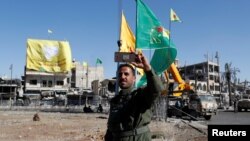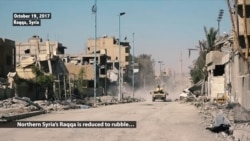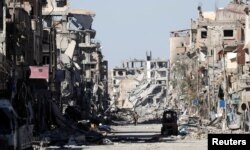The U.S.-backed Syrian Democratic Forces (SDF), an alliance of Kurdish and Arab troops, announced earlier this week that they had captured Raqqa, an Islamic State stronghold and the terror group’s former de facto capital.
While the recapture Tuesday of Raqqa is a significant blow to the Islamic State terror group, images emerging from the city show that the cost of four months of grueling battle to oust IS militants has been enormous, with most of the buildings reduced to rubble and tens of thousands of its residents displaced.
WATCH: Raqqa Lies in Rubble After Years of Islamic State Rule
The Syrian Observatory for Human Rights reported more than 3,200 civilians lost their lives during the battle for Raqqa.
Stéphane Dujarric, spokesperson for the U.N. secretary-general, said that all parties in Raqqa are obligated to ensure the protection of civilians and their rights.
Obligation to protect citizens
“The secretary-general continues to follow closely the situation in Raqqa, Syria. He [Antonio Guterres] recalls the obligation of all parties to the conflict to protect civilians and abide by international humanitarian and human rights law,” Dujarric said.
“He [the U.N. secretary-general] also urges the parties to facilitate humanitarian access in order to allow aid to reach those in need without delay,” Dujarric added.
Speaking to reporters in Washington during a teleconference briefing from Baghdad, Colonel Ryan Dillon, a spokesperson for the U.S.-led coalition, said forces on the ground are taking every necessary measure to protect civilians.
“In Raqqa and the rest of Syria, our focus remains on reducing risk to civilians while continuing to pursue and defeat ISIS terrorists at every opportunity as they retreat to their remaining held areas in the Middle Euphrates River Valley,” Dillion said, using an acronym for the militant group.
Displaced Raqqa residents are demanding to be allowed to return home after the expulsion of the IS militants.
But SDF authorities in Raqqa told VOA a quick return is difficult because of the extent of the damage from months of conflict.
Meanwhile, aid groups warned that help is urgently needed for people as they prepare for the winter in refugee camps.
Raqqa after liberation
Syrian Democratic Forces say the city is still far from safe because of IS-planted mines and fears that some IS fighters might be hiding among civilians.
“SDF now is clearing the freed neighborhoods from explosive devices and land mines, which is the most important step at this stage. This might last for a few months,” Jihan Sheikh Ahmad, a spokesperson for SDF, told VOA.
Raqqa Civilian Council, supported by the U.S. and established by SDF last April to govern Raqqa, is expected to move into the city.
Brett McGurk, the U.S special presidential envoy for the Global Coalition to Counter IS, visited Raqqa Civilian Council on Wednesday in Ain Issa, a town in northeast of Syria and pledged necessary U.S. support.
IS atrocities
IS enforced strict and brutal laws on civilians in Raqqa. The militants carried out public executions, held slave markets to sell abducted Yazidi women and children, and used civilians trapped inside the city as human shields to inhibit airstrikes against the group.
The city’s Al Naeem traffic circle, once cherished as a crowded public gathering place, has become a symbol of IS fear and terror as the group used it for public executions.
“This neighborhood used to be called Heaven. But its name was changed to Hell after IS, because it was used to execute and behead people,” Ismail Khalil, a Syrian Democratic Forces media organizer, told VOA.
SDF officials say it is hard for life to quickly return to normalcy after years of brutal rule by IS, but they remain optimistic for a new start.
“I grew up in a diverse neighborhood in Raqqa. My neighbors were Arabs, Assyrians, Kurds, Christians and Yazidis. We lived together as Syrians,” SDF spokesperson Ahmad recalled. She hopes that IS atrocities will be followed by a brighter future for all Syrian citizens.














